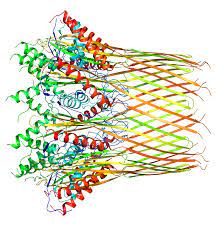 The Curli protein is a type of amyloid fiber produced by certain strains of enterobacteria.
The Curli protein is a type of amyloid fiber produced by certain strains of enterobacteria.
Curli are extracellular fibers located on bacteria such as E. coli and Salmonella spp.
These fibers serve to promote cell behavior through biofilm formation in the extracellular matrix.
Amyloids are associated with several human neurodegenerative diseases such as Alzheimer’s disease, Huntington’s disease, Parkinson’s disease, and prion diseases.
Amyloids have been linked to illnesses such as Alzheimer’s, Parkinson’s, Huntington’s, lupus, among others.
The Curli protein (Csg protein), is a type of protein found in certain bacteria involved in the formation of biofilms, which are communities of bacteria that stick together on surfaces.
Curli proteins are important for the bacteria’s ability to adhere to surfaces and form a protective matrix.
They contribute to the formation of a fibrous structure called a curli fiber, which helps bacteria to attach to different surfaces such as plant roots, medical devices, or host tissues.
Curli proteins are made up of two main subunits, CsgA and CsgB.
CsgB acts as a template for the assembly of CsgA subunits into the curli fiber.
The curli fibers are composed primarily of CsgA subunits and can form a network that provides structural stability to biofilms.
Curli proteins also have functional implications, as they can interact with host cells and the immune system, leading to various responses such as inflammation and immune cell recruitment.
The curli protein is considered a PAMP (Pathogen-associated molecular pattern).
Its β-sheet structure is recognized in the innate immune system and activates the TLR2 (Toll-Like Receptor 2), which
then causes a downstream response by producing a pro-inflammatory response where pro-inflammatory cytokines and chemokines are recruited to initiate the inflammation response.
Curli, however is a “functional amyloid” including being a major component in the biofilm generated by gram-negative bacteria such as E. coli and Salmonella spp.
These biofilms allow gram-negative bacteria to better colonize in a given environment, protecting them from oxidative stress and dehydration.
These biofilms allow for the bacteria to survive chemical and physical stressors within their environment, not only do they make patients more susceptible to infection when using shared appliances, but curli and other biofilms have been shown to reduce the infected individuals’ immune response and antimicrobials.
Curli proteins and biofilms alike are very resistant to chemical stressors.
Curli fibers are involved in many different types and functions in the cell such as for cell aggregation, act as adhesive for different proteins to the cell’s surface, used in biofilm formation of certain bacteria and contain chemicals for quorum sensing, and an important role in inflammatory response in individuals.
Curli formation must also be heavily regulated.
It accumulation leads to amyloid like protein aggregations in the organism which leads to destruction of pathway and interferes with cell signaling.
Curli proteins are a type of adhesive protein found on the surface of certain bacterial species, primarily Escherichia coli (E. coli).
Curli proteins are unique in that they can self-assemble to form amyloid fibers, similar to those found in neurodegenerative diseases like Alzheimer’s and Parkinson’s.
These fibers enable bacteria to stick to surfaces and protect themselves from the immune system and adverse environmental conditions.
The formation of curli fibers is associated with several important biological processes.
Curli proteins have also been implicated in the development of persistent infections and chronic inflammatory conditions.
In certain gastrointestinal diseases, such as Crohn’s disease, E. coli expressing curli proteins have been found to exacerbate inflammation and contribute to the progression of the disease.
Understanding the function and regulation of curli proteins is essential for developing strategies to prevent bacterial infections and combat biofilm-related issues.
The curli protein’s main components consist of the CsgA and CsgB protein.
CsgA is the major subunit of the curli protein and weighs approximately 13.1 kiloDalton.
CsgA protein consists of three domains which have a tendency to aggregate and form amyloid fibrils.
The amyloid core domain is composed of 5 repeating (yet not exact) sequences and is the characteristic subunit that forms its aggregatable β-sheet.
CsgB, also known as the minor subunit, is required for the nucleation and organization of CsgA into a curli fiber on cell surfaces.
CsgB has a very similar repeating sequence to that of CsgA with the exception that one of the 5 repeating sequences contains additional amino acids, and the final R5 subunit is required to properly form on cell surfaces.
The CsgC subunit prevents the aggregation and polymerization of the CsgA protein.
Without CsgC, there is a chance for amyloid fibril formation and even cell death.
The molar ratio required for CsgC to inhibit CsgA is 1:500, meaning only 1 CsgC protein is required to inhibit 500 CsgA proteins from forming amyloid fibril structures.
